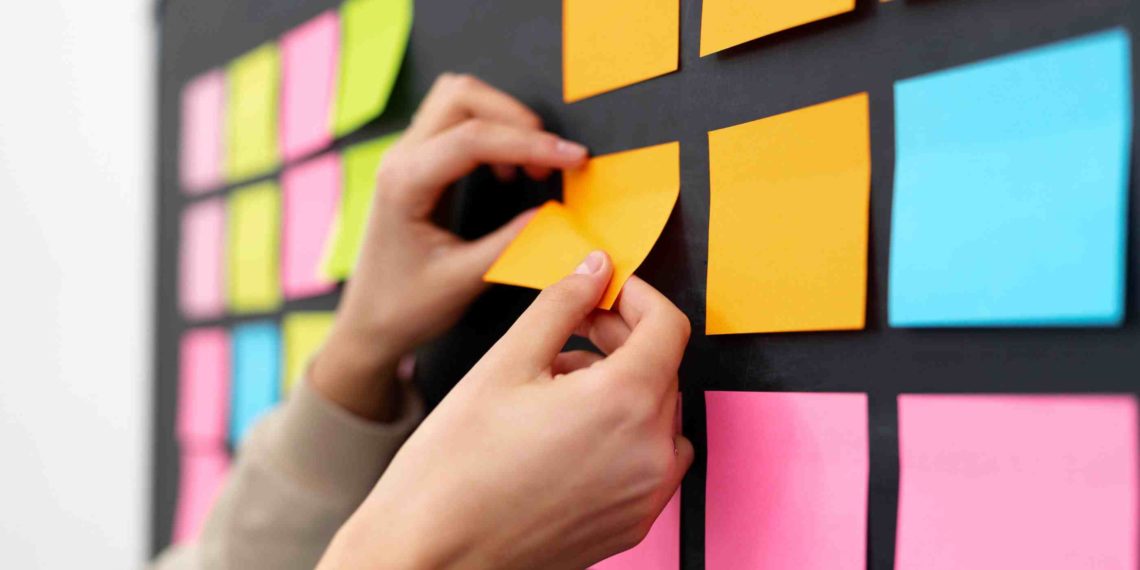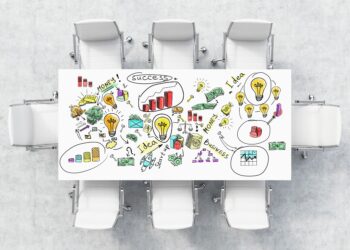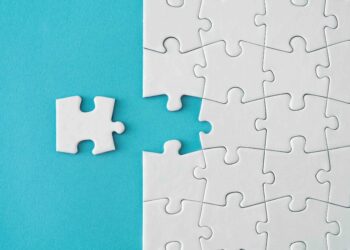The journey towards a well-crafted product sometimes hits problems along the way. It may turn out hard to assess development stages, backlog may start getting gaps, the planned release may be disrupted, or the teams could even disagree on who contributed the most. In order to avoid such problems, a new tool appears as the ideal help you’ll need, and it is called User Story Mapping.
With the help from this technique, the team has a clear understanding of the project as a whole, as it gets divided into iterations from idea to release. Visual design helps see the relationship between individual stages, correctly set priorities, and never miss important tasks.
In this post, we’ll discuss how to prepare for a User Story Mapping session, who needs to be invited to the meeting, and how to accompany the process in order to get a good result.
1. What Is User Story Mapping?
User Story Mapping is what we call a mapping creation technology. Such a tool is a great way to bring together everyone involved in the project, as it helps visualise all tasks, and display what a user’s journey through the product looks like. This is the quintessence of everything you know about users, and the tasks and actions which are the most important to achieve.
User Persona, User Story, and User Journey: Get the Basics
The eventual user map (User Story Mapping) relies on three tools: User Persona, User Story, and User Journey:
- User Persona describes a specific user with goals and problems that the character hopes to solve with the product. From then, several types of users can be either considered individually or grouped according to their goals and problems.
For example, possible users could be a casual user, a business user, or a power user. - User Story is a couple sentences describing what a user wants to achieve with your product. Usually, stories are created according to the following pattern: “As a (type of user), I want (goal/desire) so that (benefit and value).” For example, ‘’I want to click on the button to leave my information and get a free book.’’ The other technical format of story creation aims to find ways to simplify the performance of actions frequently used by the client and provide the desired result in just “two clicks.”
- User Journey describes the client’s tasks and actions, experience, emotions, thoughts at all stages of interaction with the product. The user’s steps are thought out and then fixed in the team-friendly format: On paper, on Trello board, or visualisations in MIRO or similar tools. User Journey steps will be required to create a “skeleton” base of User Story Mapping. User Journey can be created by people who directly work with users: UI/UX specialists, marketing or product team, analysts, user research specialists, project managers, and of course, product owners and product managers.
All together, they will form a map. This map of user stories will be helpful in order to:
- Keep focusing on the customer and their progress with the product;
- Visualise user’s steps (User Journey);
- Clearly show the relationship between the client’s actions and the User Story;
- Allow you to see additional opportunities, leading to the emergence of good ideas;
- Form a common understanding among all stakeholders.
User Journey: A Practical Example
Let’s take for example a person buying a cinema ticket online and then exchanging this digital version for an actual ticket at the cinema ticket booth. Which actions does the user have to do, and in which specific order?
The steps in User Journey may look like this:
Go to the website → log in → choose a movie → select time and date → choose seats → indicate the number of tickets → pay → go to the cinema → queue for the exchange → enter the hall → find a seat → watch the movie.
The list should include all steps to achieve the desired result, and watching the film is not necessarily the ultimate goal, as it will depend on the user. They might want to buy a ticket online to:
- Get a paper ticket and give it to someone as a gift;
- Exchange for the paper version and see the film in a week;
- Email it to a friend – this may be your crazy idea, which later becomes an additional feature!
The first point you have added to User Journey can be the user’s entry point, both to the product itself and one of its features. For example, all users need to open an app or a website, but there can be different ways to access the ticket selection screen.
Please note that there are many more possibilities than the above-mentioned example, as a User Journey will also change depending on the User Persona, their ultimate goal and their behavioral pattern.
2. How to Prepare for User Story Mapping?
Now you got the basics right, it’s time to prepare for your first User Story Mapping session, and you may know preparation is key to success. For the meeting to be productive, think out a few things in advance: Having enough time, creating a list of participants, and choosing a place to hold the meeting at will be key elements for a fruitful session.
Invite the right participants
For the first session, gather stakeholders who look at the product from different positions:
- Users’ representatives: People with user experience, support specialists who help customers pass all stages;
- Relationship managers and user researchers: If the company has such profiles, invite them because they know what users know and where they find difficulties;
- Development teams’ representatives: They will be able to communicate the session results to the rest of the team;
- The product owner, who will facilitate the session;
- UI/UX specialists;
- IT Architects: Experts who will show stakeholders the order of changes and make sure the platform or the product will sustain the changes.
Prepare a basic scheme
Build a “skeleton” base (User Journey), a set of all the steps that the user will take on the product plus his actions in each step:
- The upper horizontal line, the “spine,” is the User Journey, the client’s steps mentioned in the exact order in which the person performs them;
- Vertical lines, “ribs,” are action details for each step, arranged by priority order (top to bottom).
Organise the workspace
You will need an online or offline board and coloured stickers to indicate different tasks or activities for the session.
For example, user path – green stickers; something from User Story – yellow; possible difficulties – red; all business preferences about priorities or releases – small bright stickers with the size of a quarter of a sticker.
When the stakeholders enter the room, everything necessary for the process should be already prepared:
- Sample legend – sticker examples with text written on them, placed in a particular place, so people can understand which colour to use.
- Parking spot – space for noting questions and potential complications.
- Territory for the map itself: If the meeting is offline, the map can be a particular board, a wall, or even a window. To build the map remotely, use digital tools such as cardboardit.com, storiesonboard.com, craft.io, or MIRO.
- Space for new crazy ideas on the right of the card: You can note the ideas that have arisen during the discussion and may be implemented in the future.
- Data corner: Here will be placed all information about the User Persona. When you add some feature, the data for it is also placed in the data corner. The example of buying a movie ticket can be analytics: What percentage of users buy tickets for someone else, what people do with a ticket after payment, etc.
3. How to Run User Story Mapping?
Preliminary preparation has been carried out: The user’s step-by-step path has been prescribed, information about the client has been collected, portraits of personas have been made. The meeting holding space is appropriately organised. It is now time to invite stakeholders and start the session.
It’s usually useful for User Story Mapping to run for at least three stages. Visually, the map of the stories at all three stages looks like a horizontal “spine” line and vertical “ribs,” but the goals for each stage of the creation will be different.
Stage 1: Creating details
User Journey is made in advance and has steps placed in order of implementation: It appears as a horizontal line with red squares in the picture below. Green stickers – actions – are created directly at the meeting with the participants. The duration of such a session is about 2 to 3 hours.
The goal will be to create the details that the user will take at each step.
In the cinema ticket example, the horizontal red line is the sequence of all steps a person takes when paying for and receiving a ticket.
Now you need to work out vertical “ribs” for each step.
What examples of user stories can be thought of for the phase when the user chooses a place on the site or in the app?
For example:
- “I want to see the available seats, so I choose the closest to the exit, the most comfortable.”
- “I want to see the hall’s scheme to select suitable seats for a large company.”
When considering examples, consider two scenarios for each action, called ‘’happy flows’’: One in which the user succeeds, and one in which the user fails.
At this stage, additional information may appear in the data corner, such as:
- Goals and weaknesses of the entreprise;
- Types of users using the system;
- And goals or weaknesses of the user.
Record all ideas – even the strangest ones – in the corner for crazy ideas. For example, the ability for registered users to see their favorite places first or see where their friends will be seated if they gave their consent. These features might not be a top priority, but they can be introduced later into the product. That is why such ideas need to be visualised, too, so nothing is lost in the discussion process.
Stage 2: Refining the prepared map
All actions are now written down, difficulties have been voiced, and ideas are recorded. It’s now time to evaluate and prioritise decisions. To do so, call for another meeting by slightly changing the circle of participants. Indeed, representatives of business, users, and development are the only necessary participants to help set priorities correctly. Select what will appear in the first release in a different colour and separate the releases from each other by tracing lines.
The goal here will be to highlight more and less critical actions for your business and draw a line on what will appear in the first, second release, or iteration.
Stage 3: Developing the technical component
Then comes the third stage, in which the development team specifies the functional details that the user will need for each action: Frontend, backend, and others.
The actions of the system are created for each persona-actor. Using our cinema ticket example, an actor can be a ticket buyer, a friend who was given a ticket, a cashier, a cinema owner, … Every actor has a purpose and value in using the product.
At the same time, the development team also splits actors by function: Frontend, backend, testing, design, … Several specialists usually implement each feature with a different amount of work on features.
The developer, the tester, and the user experience manager will help you detail and evaluate all gathered data correctly.
The goal here is to determine which functions are needed for a minimum viable product and briefly state the intention of the system, meaning what it must do for the user.
After those three stages, you now have a clear vision of actions that have to be taken by each team. Start implementing what you have planned in those sessions. Refer to the map all throughout the project’s life, by adding new details, updating priorities, marking completed tasks, etc.
4. Check List on User Story Mapping
Here’s now a check-list of every step of User Story Mapping:
- Place the user’s steps (User Journey) horizontally to answer the question: “What do people do with this system?”
- Move the steps in the order in which the user “travels on the product.”
- Under a client’s step or multiple steps, write out a User Story, which can be divided into small tasks if necessary.
- Look for similar actions performed by similar people to achieve similar goals. Use different colours to prioritise.
- Determine what will appear in the first release with a list of the main actions that the application supports. It can be a more refined release or a model called “walking skeleton” – a software that supports the least number of necessary tasks while interacting with the user.
- After each release, make changes to the overall picture and re-prioritise the tasks.
User Story Mapping helps manage projects flexibly and work with the customer’s requirements, presenting them visually. Building custom maps allows you to correctly set and plan tasks, take changes into account and, ultimately, increase the company’s profit.
If you want to use User Story Mapping for the development of a new product or a new iteration, Wemanity Learning Center is there to help you. Together, let’s make your first User Story Mapping session a success!
In summary :
User Story Mapping is what we call a mapping creation technology. Such a tool is a great way to bring together everyone involved in the project, as it helps visualise all tasks, and display what a user’s journey through the product looks like. User Story Mapping relies on three tools: User Persona (who are the users?), User Story (what do they want?), and User Journey (the different steps the user takes).
For the meeting to be productive, think out a few things in advance: Having enough time, creating a list of participants, and choosing a place to hold the meeting at will be key elements for a fruitful session. Invite participants who will look at the product from different angles, prepare in advance a basic scheme to be used during the sessions, and organise the workspace for everything to be ready before the stakeholders join you.
It’s usually useful for User Story Mapping to run for at least three stages. Visually, the map of the stories at all three stages looks like a horizontal “spine” line and vertical “ribs,” but the goals for each stage of the creation will be different. The first stage will be about creating the details of the map, while the second stage will refine those details. The third stage will then focus on the technical aspect of the product’s development.












